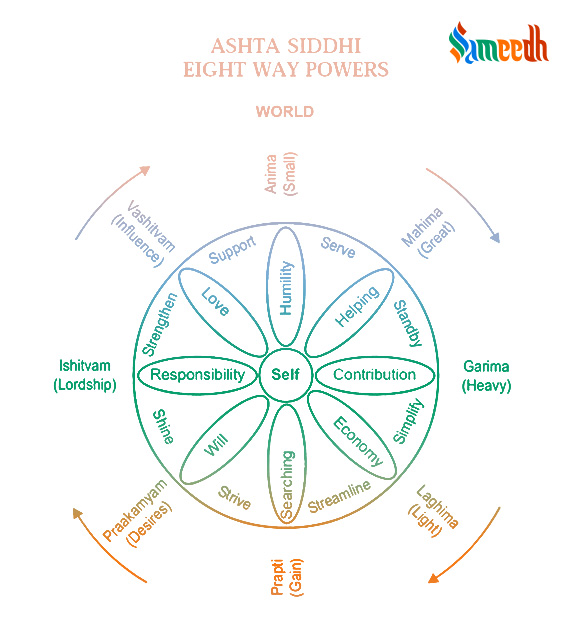In Hinduism, the concept of siddhis refers to spiritual powers or attainments gained through intense spiritual practice, meditation, and mastery over the mind and body. .There are 8 types of spiritual attainments or Siddhis in Hinduism.

Siddhi is the Sanskrit word for accomplishment. It can mean anything from a range of achievements such as mental, physical, spiritual, supernatural etc. Attainment of knowledge, success or prosperity too is known as Siddhi. It is believed in Hinduism that by practicing Yoga and Meditation regularly with a concrete state of mindfulness, one can acquire enough knowledge to procure all these Siddhis, although it is extremely difficult to do so.
There are various lists of siddhis mentioned in Hindu scriptures, but one common classification is the group of eight primary siddhis. These eight siddhis are often mentioned in texts such as the Yoga Sutras of Patanjali and various Tantric texts.
According to Hindu tradition, these siddhi’s are:
- Anima: The ability to become small or diminutive in size. It represents mastery over the physical body and the ability to transcend limitations.
- Mahima: The ability to become large or expand in size. It symbolizes the expansiveness of divine consciousness and the potential for boundless growth.
- Laghima: The ability to become weightless or extremely light. It symbolizes freedom from attachment and the ability to rise above earthly concerns.
- Garima: The ability to become extremely heavy. It represents the grounded Ness and stability that come from aligning with divine power.
- Prapti: The ability to reach or attain anything, anywhere. It represents the fulfillment of desires through spiritual alignment and divine grace.
- Prakamya: The ability to manifest anything by will. It signifies the harmonization of individual desires with universal will and the power of focused intention.
- Ishitva: The ability to have control over all beings. It represents mastery over creation and the ability to govern the universe in alignment with divine purpose.
- Vasitva: The ability to have control over all elements of nature. It signifies the mastery over the ego and the ability to influence and guide others toward spiritual growth and realization.
These powers are believed to be attainable by those who have reached a state of spiritual enlightenment through yoga and meditation. According to Hindu tradition, the attainment of these powers is not the ultimate goal of spiritual practice, but rather a byproduct of spiritual development and self-realization.
In Hindu mythology and tradition, there are numerous accounts of saints, sages, and divine beings who are said to have attained various siddhis throughout history. However, it’s important to note that these stories are often passed down through oral tradition and mythological texts, and historical verification of such events can be challenging. Here are a few examples of figures from Hindu mythology and history who are associated with the attainment of siddhis:
- Lord Hanuman: In the Hindu epic Ramayan, Hanuman, the divine monkey deity, is depicted as possessing various siddhis. He is said to have exhibited extraordinary strength, the ability to change his size at will, and the power to fly through the air. Hanuman’s devotion to Lord Ram and his unparalleled loyalty are often cited as factors contributing to his attainment of siddhis.
- Sage Patanjali: Sage Patanjali is traditionally credited with compiling the Yoga Sutras, which outline the principles and practices of yoga. In some traditions, he is also regarded as a master of siddhis. Patanjali’s teachings emphasize the importance of spiritual discipline and meditation in attaining higher states of consciousness and supernatural abilities.
- Sage Agastya: Sage Agastya is a revered figure in Hindu mythology and is associated with various siddhis, including the ability to control natural forces and manipulate elements. He is said to have played a significant role in spreading knowledge, particularly in the fields of Ayurved, astrology, and spirituality.
- Sage Durvasa: Sage Durvasa is renowned for his short temper and fierce demeanor, but he is also believed to have possessed great spiritual powers. He is said to have attained siddhis such as the ability to curse or bless individuals and to perform miraculous feats through his tapas (austerities) and devotion.
- Lord Krushna: In Hindu mythology, Lord Krushna, an incarnation of the god Vishnu, is depicted as possessing various siddhis. He demonstrated extraordinary powers from childhood, including lifting the Govardhan Hill, defeating powerful demons, and performing miraculous deeds to protect his devotees.
These are just a few examples, and there are many more stories and legends throughout Hindu mythology and history that mention individuals who have attained siddhis through their spiritual practices and devotion. It’s important to approach these accounts with an understanding of their mythological and symbolic significance within Hindu culture and spirituality.
These eight siddhis represent different aspects of spiritual attainment and mastery over the physical and metaphysical realms. They serve as a framework for understanding the potential of the human spirit and the transformative power of spiritual practice in Hinduism.